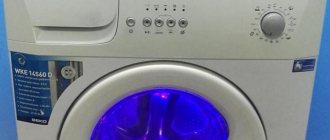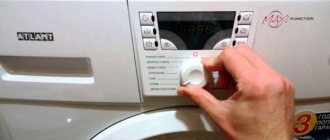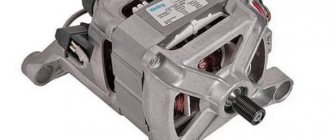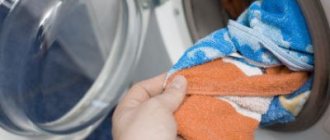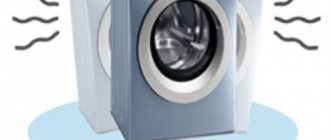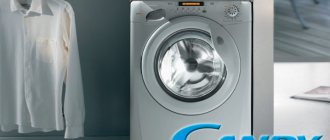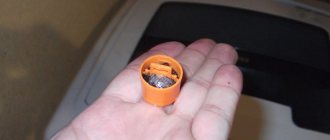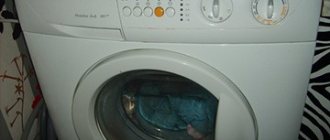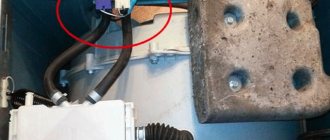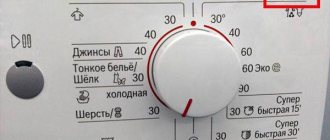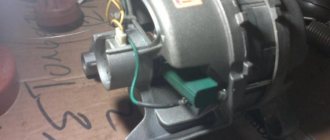Have you loaded the laundry into the drum and are trying to slam the door, but it won’t close? What happened: the lock does not work or the latch does not fit into the loop? There may be several reasons: from trivial problems to breakdowns requiring repair.
If your washing machine does not close the door, conduct a self-diagnosis and fix the problem.
Causes of malfunction
Why doesn't the hatch door latch? The reasons are divided into two categories: mechanical and electronic.
If there are mechanical problems, you will not be able to close the door at all; it simply will not lock. This happens because:
- The plastic guide is broken or worn. This is a typical failure for washing machines under the Kandy and Indesit brands. Therefore, when choosing a machine, it is recommended to ensure that the guide is metal. In this case, the guide is not fixed in the lock hole and will need to be replaced.
- The door hinges are warped. Then the locking tongue does not reach the hole and cannot tightly latch the hatch door. All you need to do is tighten the screws that secure the hinges with a screwdriver.
- The hook tongue has moved. This leads to a similar problem, only the reason is no longer the loops. To tighten the tab, you will have to disassemble the door handle.
If problems arise with the electronic locking, the hatch will close mechanically normally. But you will not hear a characteristic click, water will not be poured into the tank.
In case of such breakdowns, an error appears on the display that the door is not closed.
Why the lock does not turn on:
- The UBL lock is broken. After the hatch is latched with the hook tongue, the hatch locking device is activated. The blocker sends a signal to the electronic module, which opens the valves for water intake. If the UBL does not work, then washing is impossible.
- Debris has entered the electronic lock connector. Perhaps some small debris is clogged, so the blocking does not work.
- If the door is blocked normally, but the program does not start, the reason is in the control module, which “does not see” the closed door.
What you can do yourself
Often the car does not close for simple reasons:
- The door is not closed tightly. They simply didn’t push it through to the end. Therefore, the lock did not close and the lock did not work. Open the hatch again and close it, pressing lightly. Turn on the program. If everything is normal, you will hear the lock click and the door will lock.
- The laundry got caught in the door. The lock does not close when laundry gets between the door and the body. Open the machine and see how things are stacked in the drum. Tuck the protruding ends inward and close the washer again. Run the program again.
- Control module failure. Occasionally, the UBL does not block the hatch of the washing machine due to a failure in the control module. Electronics are sensitive to power surges. If at the moment the program starts the voltage increases sharply, the program is lost and the module does not give the command to block the hatch. To fix the problem, unplug the SMA for 10–15 minutes. Then turn it on again and start the wash.
- Debris got into the UBL groove. The lock is hidden inside the case. When it is closed, the lock tongue on the door fits into the groove on the UBL, and the door is locked. Sometimes debris accidentally gets inside the groove, then the tongue does not reach the UBL, and the hatch does not lock. Check the hole on the SMA body, remove any debris and close the door again. After the program starts, you will hear a lock click.
From the practice of masters! If there is a small child in the family, small Lego parts, candies, chewing gum, candy wrappers and other items often end up in the UBL slot. This results in the washing machine door not closing.
Have you checked how the laundry is lying, whether there is any debris in the groove, closed the door more tightly and even turned off the machine, but nothing has changed? This means that the reason is still a malfunction, and your equipment needs professional help.
How to fix the situation
If the door does not close tightly, and after inspection you find that the tongue or guide is misaligned, you need to replace it.
- Unplug the washing machine.
- Using a screwdriver, unscrew the hinge screws and remove the door from the body.
- Place the door on a flat surface and begin disassembling. You first need to buy a repair kit for your model. Most likely, you will have to buy the entire pen, which includes a tongue.
- Unscrew the screws around the perimeter, release the latches and remove the inside of the door.
- Before disassembling the handle, take a photo of the location of the parts.
- Push and remove the pin, after which nothing will hold the parts.
- Reassemble the handle in reverse order, installing a new tab.
What should I do if the SMA display says that the door is not closed? This means the electronic lock is not working. Indicators on mechanical panels may flash. The UBL device needs to be replaced.
- Open the hatch door and unscrew the two bolts securing the device.
- Bend back the sealing rubber.
- Remove the clamp and tuck the cuff inside the drum.
- Take out the UBL device and disconnect the wiring from it.
Inspect the wiring. If burnt parts are visible, it needs to be replaced. The UBL is checked for resistance with a multimeter. If the lock is faulty, replace it in reverse order.
Testing UBL
To check the operation of the lock, there is a special tester (the most suitable option is a multimeter with a large range). However, in order to use such a device, the hatch door must be removed.
- Loosen the clamp that holds the front wall cuff in position. Depending on the clamp (and they are different), use either round-nose pliers, a screwdriver, or pliers.
- To find the UBL, you need to remove the cuff from the front wall.
- Remove the two screws (that hold the lock in position) from the outside where the lock hook contacts the lock device.
- Disconnect the wires and remove the UBL (it is no longer secured) through the hole between the cuff and the machine body.
In order to proceed further, it is necessary to study the special hatch lock diagram. As a rule, such a device is found in almost any car, but each company installs it in its own way (the contacts are different), and we need to know the purpose of each contact in advance, otherwise nothing will work. Find such a diagram on the Internet and find out where the phase, neutral, and common contacts are. Only after this is it possible to check the blocking with a tester.
- The device toggle switch must be switched to resistance test mode.
- Place the probe on the neutral and phase contacts of the lock.
- After this, the device should show a three-digit number.
- Next, the probes should be installed on the common and neutral contacts.
- If you see 0 or 1 on the device, this indicates a malfunction of the device.
As can be seen from our story, some defects in your machine can be eliminated with little effort and almost instantly, while some will require a certain amount of effort and time. However, in any case, these problems can be solved both independently and with the help of a specialist.
Interesting:
- LG washing machine hatch won't close
- The best automatic washing machine - what is it?
- Dishwasher door won't stay open when open...
- The hatch of the Indesit washing machine does not close
- The washing machine door does not close tightly
- Door error in washing machines
Reader comments
- Share your opinion - leave a comment
How to solve problems with the electronic module
You figured out the lock of the washing machine, inspected it, and found no damage. How to determine that the cause of the malfunction is in the module:
- The door blocks, but does not erase.
- The “Lock” indicator does not light up on the display.
If any element or triac of the module burns out, then any part of the washing machine may fail. For example, a UBL may work properly, but the control unit does not recognize its signals. Or the triac of the fill valve is faulty, so water intake does not start.
Carefully inspect the board and its wiring at the time of scorching. Let's look at how to get to the module, but it is not recommended to repair it yourself.
- After disconnecting the SMA from the power supply, remove the top cover from the housing.
- Remove the dispenser tray by pressing the latch in the center.
- Remove the screws holding the control panel.
- Unlock the latches and detach the panel from the body.
- When disconnecting the wiring, inspect it for damage.
- To remove the board from the panel, you must also release the latches.
If you do not see any signs of damage, take the board to a service center. They will carry out professional diagnostics and repairs.
As you can see, some breakdowns can be fixed on your own. But there are situations when you cannot do without a specialist - do not take risks and entrust complex repairs to specialists.
Causes of washing machine door failure.
The door in the washing machine may not close completely for the following reasons:
- The door may become warped over time
. You can adjust the misalignment with bolts yourself or contact a washing machine repairman. - The tongue that secures the door may become warped
. The rod holding it in place may have fallen out of the tongue. In this case, the door can be disassembled and the tongue inserted back. If you are afraid to repair the door yourself, then contact a washing machine repair service. - The door guide may become deformed
. Because of this, the door in the car will not lock in the closed position. In this case, the guides must be replaced immediately.
But what is the reason that the washer door closes but does not lock when you try to turn on the wash?
Internal problems of the washing machine
It happens that the hatch door in the washing machine closes without problems, but the machine does not work. This is most likely due to the hatch locking device (HDU).
The hatch locking device may fail due to deformation of the bimetallic plate. This plate is responsible for preventing the washing machine from flooding the room in which it is located. But over time, the plate wears out. In this case, the bimetallic plate needs to be replaced at a washing machine repair service.
Some foreign object could have gotten into the UBL. It can be anything. To fix this problem, you need to disassemble the hatch locking device and diagnose it. It is better if the analysis is carried out by a washing machine repairman, and not by an ordinary person.
The problem with the UBL can also be directly related to the control module of the washing machine. The module may break or become deformed and then it simply will not send UBL signals. In this case, you first need to diagnose the UBL and then repair it or change it, depending on the nature of the malfunction.
Possibility of self-repair
Is it possible to carry out repairs on my own if the door of the washing machine does not close tightly? This question cannot be answered unambiguously, since everything will depend on the nature of the existing damage:
- If the machine breakdown is due to mechanical damage, or if the lock on the door is simply jammed, then the machine can be repaired at home using a screwdriver. Disassemble the drum and tighten the tongue. If the problem is related to the guide, then it must also be replaced using tools.
- You can repair the door yourself if the rubber band is frayed. You just need to remove the old rubber band from the drum and glue a new one. You can order a new elastic band (or cuff) online, or look for it in hardware stores.
- If the damage in the washing machine is related to the electronics - UBL, control module or something else, then you need to call a technician and do not get into the machine yourself.
In general, it is best to entrust all washing machine breakdowns to professionals from a washing machine repair service. This way you will save yourself from additional expenses that may follow unprofessional repairs.
You can also independently diagnose the machine once every six months. This can prevent all possible breakdowns.
Use your washing machine carefully and be happy!
Internal causes and their solution
If the washing machine door does not close, this may be caused by a malfunction of the electronics. Often problems arise as a result of a malfunction of the hatch locking device (UBL).
Broken hatch locking device
When one or another washing mode is turned on, current is supplied to the UBL. This causes the contact to close. If the UBL breaks, this does not happen and the electronics do not receive a signal from it, so the wash cannot be started. To return the machine to functionality, the damaged UBL must be replaced.
Debris entering the UBL
Problems with the operation of machines from Indesit and other manufacturers may also be associated with debris getting into the UBL. In this case, the device must be cleaned or replaced.
Mechanical failure
If the door lock is damaged, there will be no characteristic click after closing the hatch. There are different reasons for this: the hatch was slammed too hard, something heavy was lying (hanging) on the open door, children were riding on it, and so on. Elementary wear and tear from time cannot be ruled out. The table below shows the main possible mechanical faults and how to deal with them.
List of causes of mechanical failures
| Malfunction | Solution |
| The hatch does not close completely, leaving a gap. |
|
| The hatch door closed, but there was no clicking sound. Fixation does not occur. |
|
